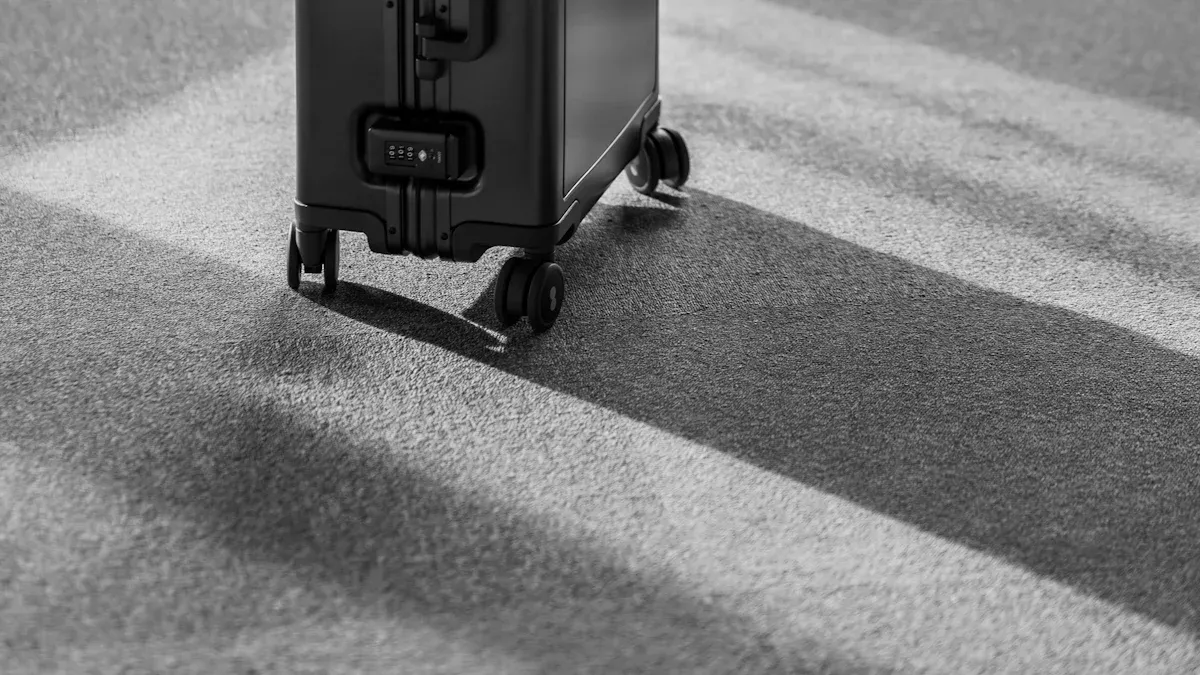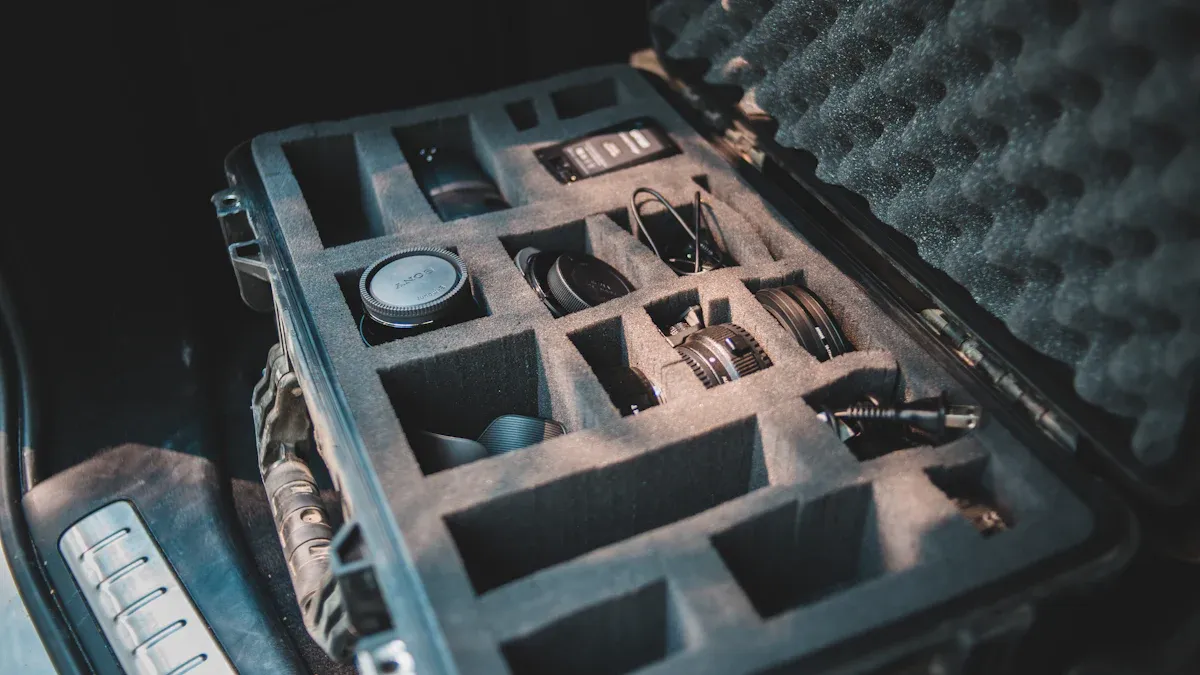
For 2025, a professional Studio Equipment Trolley Case requires specific features. Superior build quality, customizable interior organization, robust wheels, secure locking mechanisms, and ergonomic design are essential. These attributes protect and transport valuable gear effectively. They also ensure a worthwhile investment.
Key Takeaways
- A good studio trolley case needs strong materials to protect your gear from bumps and water.
- Look for cases with wheels that roll smoothly and handles that are comfortable to hold.
- Make sure the case has strong locks and ways to organize your equipment inside.
1. Superior Build Quality and Durability in a Studio Equipment Trolley Case
A professional Studio Equipment Trolley Case demands exceptional build quality. This quality ensures the case protects valuable gear through various environments. Durability is not merely a feature; it is a fundamental requirement for reliable equipment transport.
Impact-Resistant Materials
The foundation of a durable case lies in its materials. Manufacturers often use polypropylene in the construction of the case. This material provides excellent resistance to impacts. Impact-resistant injection-molded polymer is another key feature in robust case construction. These advanced polymers absorb shocks effectively. They protect delicate equipment from accidental drops and harsh handling. Such materials ensure the case maintains its structural integrity over time.
Water and Dust Resistance (IP Ratings)
Environmental protection is paramount for sensitive electronics. Water and dust resistance safeguards gear from adverse conditions. Industry standard IP ratings indicate a case’s level of protection. A higher IP rating signifies superior defense against moisture and airborne particles. This feature prevents damage from rain, spills, or dusty locations. Professionals rely on these ratings to guarantee equipment safety in any setting.
Reinforced Corners and Edges
Corners and edges are often the most vulnerable parts of any case. Strong metal edges at the corners prevent crushing. Some designs feature heavyweight nylon with reinforced corners. A 33-inch roller hard case often incorporates reinforced corners made from high-quality, durable plastic. Heavy-duty cases also include reinforced edges and corner guards. These plastic constructions absorb impacts effectively. They distribute force, protecting the contents. This reinforcement significantly extends the case’s lifespan.
2. Customizable Interior Organization for Your Studio Equipment Trolley Case

Effective organization within a Studio Equipment Trolley Case is crucial for protecting gear and streamlining workflows. A well-designed interior prevents items from shifting during transport, minimizing potential damage.
Pick-and-Pluck Foam vs. Padded Dividers
Professionals often choose between pick-and-pluck foam and padded dividers for interior customization. Pick-and-pluck foam offers superior customization. Its pre-cut cubes allow for a personalized fit without specialized tools. This foam provides excellent shock absorption and cushioning, making it cost-effective and quick to configure. However, pick-and-pluck foam has limitations. It often falls apart over time and is not reconfigurable. Once users pluck the foam, they cannot undo mistakes, and a new insert becomes necessary if the setup changes. This low-density foam degrades with heavy use, and its pre-cut nature makes it prone to disintegration. Padded dividers, conversely, offer long-lasting durability. Their Velcro design allows for easy reconfigurability, accommodating changing equipment setups with simple adjustments.
Adjustable Compartments
Adjustable compartments provide essential flexibility. They allow users to reconfigure the interior layout to fit various equipment sizes and shapes. This adaptability ensures a snug fit for all items, preventing movement and potential damage. Professionals can quickly modify these compartments for different shoots or projects, maximizing the case’s utility.
Lid Organizers and Accessory Pockets
Lid organizers and accessory pockets enhance the functionality of any Studio Equipment Trolley Case. These features provide dedicated spaces for smaller items like cables, memory cards, batteries, and filters. They keep these accessories secure and easily accessible, preventing them from getting lost or tangled with larger equipment. This organized approach saves time during setup and breakdown, contributing to a more efficient workflow.
3. Robust and Smooth-Rolling Wheels for Your Studio Equipment Trolley Case

Reliable wheels are indispensable for any professional Studio Equipment Trolley Case. They ensure effortless transport of heavy gear across diverse environments. High-quality wheels prevent strain and protect equipment from jarring movements.
Wheel Type and Quality
The type and quality of wheels significantly impact a case’s performance. Many premium cases feature inline skate wheels. These wheels offer excellent durability and smooth rolling on various surfaces. Manufacturers construct them from robust materials like polyurethane. This material resists wear and tear effectively. Some cases also utilize heavy-duty casters. These casters provide superior maneuverability, especially for larger, heavier cases. Professionals demand wheels that withstand constant use and heavy loads.
Bearing Quality for Smooth Movement
High-quality bearings are crucial for effortless movement. Low friction bearings ensure smooth, silent operation. Many cases feature soft rubber tread wheels. These non-marking wheels provide silent, effortless movement across various surfaces. Manufacturers build these components with industrial strength and quality construction. They aim for the best performance. This commitment ensures durability and longevity, often backed by a lifetime warranty.
Wheel Size and Terrain Adaptability
Wheel size directly affects a case’s ability to navigate different terrains. Larger wheels generally handle rougher surfaces more effectively. They roll over obstacles like cables, uneven pavement, and gravel with ease. Smaller wheels work well on smooth studio floors or carpeted areas. Professionals often choose cases with wheels designed for versatility. This adaptability allows them to transport gear seamlessly from indoor studios to outdoor locations.
4. Secure Locking Mechanisms for a Professional Studio Equipment Trolley Case
Secure locking mechanisms are paramount for protecting valuable equipment. They deter theft and ensure the case remains closed during transit. Professionals demand reliable security features for their gear.
TSA-Approved Locks and Padlock Compatibility
Professionals often choose TSA-approved locks for their Studio Equipment Trolley Case. These locks bear a small red diamond emblem, the Travel Sentry™ program logo. They often show an inscription like ‘TSA001′ or ‘TSA007′, indicating the master key code. Packaging for these locks specifically states ‘TSA approved’ or ‘TSA recognized’. TSA-approved locks are recognized by the Transportation Security Administration. They feature a universal ‘master’ key. This key allows TSA agents to open and relock luggage without cutting the lock. This prevents damage to the lock and avoids delays during security inspections. Padlock compatibility offers an additional layer of security. Users can add their own robust padlocks for extra peace of mind.
Latch Quality and Material
Latch quality directly impacts case security and longevity. Reliable snapping latches ensure the case remains closed during transit. While some cases use durable plastic compounds for latches, superior materials offer enhanced protection. For instance, 304 Stainless Steel provides excellent durability for flight case hardware. Blue Zinc Plated ButterflyLocks indicate zinc-plated materials, offering good security. Marine-grade aluminum (5052, 6061 alloys) and zinc-nickel plated steel offer superior salt-spray resistance. These materials exceed 500 hours of resistance, crucial for durability in various environments. Rugged polypropylene, used for the case material, also contributes to overall product robustness.
Multiple Locking Points
Multiple locking points significantly enhance the security of a Studio Equipment Trolley Case. They distribute pressure evenly across the case’s seal. This design prevents forced entry more effectively than a single lock. Cases with several latches, each capable of accepting a padlock, offer superior protection. This redundancy ensures that even if one lock fails, others maintain the case’s integrity. Multiple locking points deter theft and safeguard expensive equipment during transport and storage. They provide peace of mind for professionals carrying high-value gear.
5. Ergonomic Design and Comfortable Handles on a Studio Equipment Trolley Case
An ergonomic design significantly enhances the usability of any Studio Equipment Trolley Case. It reduces user fatigue and makes transporting heavy gear much easier. Comfortable handles and thoughtful weight distribution are key components of this design.
Telescoping Handle Quality and Stability
A high-quality telescoping handle is essential for effortless transport. Manufacturers construct these handles from robust aluminum or steel. This construction ensures durability and prevents bending under heavy loads. The handle extends and retracts smoothly, locking securely into multiple positions. A stable handle minimizes wobbling, giving users better control over the case. This stability is crucial when navigating crowded areas or uneven surfaces.
Side and Top Grab Handles
Beyond the telescoping handle, well-placed side and top grab handles offer versatility. These handles allow users to lift the case comfortably when rolling is not an option. They feature ergonomic grips, often made from rubber or padded materials, which prevent hand strain. Strong stitching or reinforced attachments secure these handles to the case body. This design ensures they withstand the weight of fully loaded equipment.
Weight Distribution and Balance
Proper weight distribution is vital for a balanced case. An ergonomically designed case distributes its payload evenly. This prevents the case from tipping over, especially when rolling or lifting. Good balance reduces the effort required to maneuver the case. It also protects the equipment inside from sudden shifts. This thoughtful design makes the case feel lighter and more manageable, even with heavy contents.
6. Optimized Payload Capacity and Portability for Your Studio Equipment Trolley Case
Professionals require a case that effectively manages gear volume while remaining easy to transport. Optimized payload capacity and portability ensure efficiency on location.
Balancing Mobility and Payload
Achieving a balance between mobility and payload capacity is crucial for any professional. A well-designed case offers sufficient working and storage space for all necessary equipment. It often includes a height-adjustable shelf for versatility. A reliable brake system ensures stability during use. Ergonomic access to the top working surface allows for computer tasks. Excellent options for camera, cable management, and accessory mounting are also present. Compatibility with various accessories helps adapt to future equipment or workflow changes.
Sufficient Working and Storage Space
Ample working and storage space within the case allows professionals to organize their gear efficiently. This prevents clutter and ensures quick access to tools and accessories. A spacious interior accommodates cameras, lenses, lighting, and audio equipment without overcrowding. This design maximizes utility and protects valuable items.
Stackable Designs and Carry-On Compliance
Stackable designs offer convenience for storage and transport. They allow multiple cases to be securely placed on top of each other. This saves space and simplifies logistics. For air travel, carry-on compliance is essential. Most major airlines typically require carry-on cases to have maximum dimensions of 22 x 14 x 9 inches, including handles and wheels. It is always advisable to verify specific guidelines with individual airlines. Several brands offer compliant options:
| Brand | Model | Interior Dimensions (L x W x H) |
|---|---|---|
| Pelican Cases | 1510MNF, 1510SC, 1510LFC, 1510LOC, 1510TPF | 19.75 x 11 x 7.6 in. |
| SKB Cases | iSeries 3i 2011-7 (various configurations) | 20.38 x 11.44 x 7.5 in. |
| Pelican Cases | 1535 Air (various configurations), 1535TRVL | 20.39 x 11.2 x 7.21 in. |
| Nanuk Cases | 935 (empty interior, with foam) | 20.5 x 11.3 x 7.5 in. |
Prioritizing superior build quality, customizable interiors, robust wheels, secure locks, ergonomic design, and optimized payload capacity ensures optimal protection and convenience. These features provide enhanced protection, flexible storage, and easy transport for valuable gear. Investing in a Studio Equipment Trolley Case with these capabilities is a smart decision for any serious professional in 2025.
Post time: Nov-14-2025




